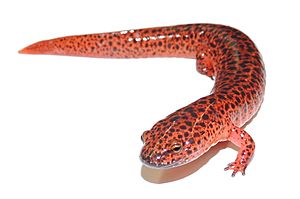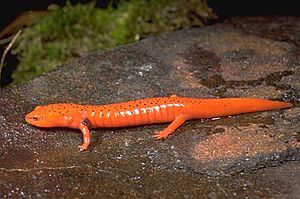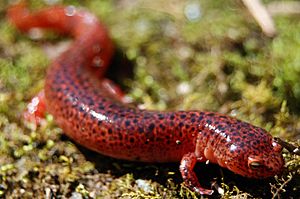Red salamander facts for kids
Quick facts for kids Red salamander |
|
|---|---|
 |
|
| Conservation status | |
| Scientific classification | |
| Synonyms | |
The red salamander (Pseudotriton ruber) is a type of salamander found only in the eastern United States. It belongs to a special family called Plethodontidae. This means it doesn't have lungs! Its skin is usually orange or red with black spots that are scattered randomly.
Red salamanders live in many places. You can find them in forests, near small creeks, ponds, and rivers. They also like areas with shrubs and freshwater springs. While they are common in many places, their numbers have dropped in some areas. This is mainly because their homes are being lost. In Indiana, the red salamander is even considered a threatened species.
These salamanders eat many different things. Their diet includes insects, earthworms, spiders, small crustaceans, snails, and even smaller salamanders. Since they don't have lungs, red salamanders breathe through their skin and the lining of their mouths.
Contents
About the Red Salamander
The red salamander is a medium-sized salamander. Adults are usually about 11 to 18 centimeters (4.3 to 7.1 inches) long. Their color can change as they get older. Young salamanders might be bright red, while older ones can be more orange-brown. As they age, their colors might become a bit darker, and their patterns less clear.
A cool thing about the red salamander is its many irregular black spots. These spots are all over its back. Even though they have bright colors and unique spots, it can sometimes be tricky to tell them apart from other salamanders.
Red Salamander vs. Mud Salamander
The red salamander looks a lot like the mud salamander (P. montanus). But there are a few ways to tell them apart:
- Spots: Red salamanders have more spots, and their spots are usually bigger.
- Eyes: The red salamander has golden-colored eyes. The mud salamander has brown eyes.
- Snout: Mud salamanders usually have a blunter (more rounded) snout.
- Color: Red salamanders tend to have a more even color all over their body. Mud salamanders often have a stronger difference between their back and belly colors.
Where They Live
There are four different types (called subspecies) of red salamanders. They all live across the eastern United States. You can find them in streams that flow through open fields, meadows, forests, and mountains. Each subspecies looks a little different in size and color.
- Northern Red Salamander (P. r. ruber): This is the most common type. It's red or reddish-orange with many black spots. You can find it from southern New York and Ohio down to northeast Alabama. It's even found in the Upper Peninsula of Michigan.
- Blue Ridge Red Salamander (P. r. nitidus): This one is a bit smaller. It doesn't have black color on its tail tip or chin. It lives in the southern Blue Ridge Mountains of Virginia, sometimes at very high places.
- Blackchin Red Salamander (P. r. schencki): This subspecies has strong black coloring under its chin. It also has spots all the way to the tip of its tail. It also lives in the Blue Ridge Mountains at high elevations.
- Southern Red Salamander (P. r. vioscai): This salamander is often purplish or salmon-colored. It usually has white spots on its head. It lives from southern South Carolina to southeast Louisiana and southwest Kentucky.
All types of red salamanders like moist places. They often hide under moss and stones near clear water sources like small streams or springs. They usually avoid very large streams.
Life Cycle and Habits
Red salamanders have interesting habits and a unique life cycle.
What They Eat
Young red salamanders (larvae) mostly eat small creatures without backbones, like insect larvae and worms. As they grow, their feeding speed changes with water temperature. They eat more when the water is warmer. Adult red salamanders are not picky eaters. They feed on invertebrates (like insects) and even small amphibians.
Reproduction and Growth
Red salamanders usually lay their eggs in the fall. The eggs hatch in late fall and winter. The young salamanders stay in their larval stage for about 27 to 31 months. Then, they change into adults (this is called metamorphosis) in the spring or early summer of their third year.
This long larval period helps them grow larger than many other salamander species before they transform. After they change, they grow up quickly. Males are ready to mate at about four years old. Females are ready at about five years old.
Where They Live and Hide
During winter, red salamanders often stay in springs or streams. In the fall and spring, they might move to different areas. Because they live partly in water and partly on land, they spend time on land until early spring. Then, they move to more watery places. Adult salamanders often live in burrows along streams. They also hide under logs and rocks on the forest floor.
Predators and Defense
Birds and small meat-eating animals like skunks and raccoons sometimes hunt red salamanders. When a red salamander feels threatened, it has a special way to protect itself. It curls its body, lifts its rear, and puts its head under its tail. Then, it wiggles its tail from side to side.
The bright red color of the red salamander might also be a warning sign to predators. It's thought that their color might copy the color of the red eft, which is a stage of the eastern newt. The red eft has a strong poison in its skin. This is a type of Müllerian mimicry, where different species that are all unpleasant to eat have similar warning colors. This helps predators learn to avoid them.
Conservation Efforts
Even though the red salamander is common in many places, its numbers are going down in some areas. This is mainly because their homes are being destroyed. As mentioned before, it is listed as an endangered species in Indiana.
Scientists believe the red salamander is a very old type of lungless salamander. This makes it important for understanding how salamanders have changed over time. To protect all salamanders, it's important to have plans in place to keep the red salamander from becoming more endangered.
Red salamanders prefer clean streams. So, it's very important to control human waste and pollution. Trash and dirt in their habitat can harm them and threaten their survival. Protecting their clean water homes helps keep these amazing creatures safe.
See also
 In Spanish: Salamandra roja para niños
In Spanish: Salamandra roja para niños




